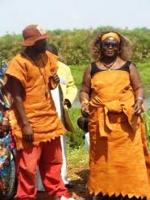List of What to See in Nairobi City
You may be worried of What to see while on your vacation or holiday in Nairobi City Kenya? This page will guide you if you want to know all the best places to visit in Nairobi City.
The centre of Nairobi is relatively compact, and although bustling with hawkers and sometimes a little intimidating, west of Moi Avenue it’s normally safe to walk around during daylight hours, although it goes without saying don’t look too ostentatious and be vigilant.
In the past there have been incidents of petty crime, bag snatching and the like, (but remember this can happen in capital cities worldwide, so keep things in perspective).
Encouragingly, in recent times there has been a clampdown on crime in the city centre
What to See
A good place to start is the Thorn Tree Café at the Stanley Hotel on the corner of Kenyatta Avenue and Kimathi Street, which has been a popular meeting spot for travellers over the years.
Kenyatta Avenue was Delamere Avenue during the colonial era and formed the core of the city at that time.
Some of the banks are fine buildings, their façades showing a faded elegance, and the northern side of the street is typical of colonial Asian architecture, with shops set back under wide, covered walkways.
It was designed to allow a team of oxen to turn around in the street — today it roars with traffic, so cross the road carefully and head north to Banda Street where you can visit the McMillan Memorial Library (open Mon-Fri 09.00—17.50, Sat 09.30—13.00) and the African Heritage Centre which has a collection of authentic African arts and crafts for sale and a café serving African food.
Turn left along the Street and take a right up Muindi Mbingu Street which will bring you to the City Market on the left.
There’s a butcher and an assorted array of fresh fruit, vegetables and cut flowers, while at the back there’s a collection of kiosks with a variety of African arts and crafts for sale — the usual kiondo baskets, Kisii soapstone carvings, and carvings of wooden animals, Maasai beadwork and jewellery and skin-covered drums.
The mamas bargain hard, all part of business, and you’re expected to do the same.
Opposite the market is the Jamia Mosque, distinctive with its decorative green and white paintwork. Keep heading north along Muindi Mbingu Street, to Biashara Street.
This is the best place to go shopping for kikois and kangas, and the Asian shops have a good selection, together with the usual safari hats and T-shirts.
Also, on the right side of the street is Atul’s, the camping shop, where you can buy camping gas canisters and hire equipment.
Continuing north along Muindi Mbingu Street, you come to Jeevanjee Gardens, a pleasant little park The Maasai Market operates on Tuesdays and Fridays from 09.00—15.00.
If a market day, cross the park diagonally to join the junction of Moi Avenue and Monrovia Street, and cross the road, where you will see an assortment of Maasai crafts for sale.
(This market is far cheaper than the Maasai Market held at Village Market on the Limuru Road each Friday which also includes curios from other parts of Africa.)
Otherwise, continue north and cross University Way and it’s a short walk along Harry Thuku Road to the Norfolk one of Kenya’s smartest hotels, where you get a bit of a culture shock after the raw energy on the streets. It was a major meeting point for the early settlers,
Lord Delamere among them, but today is more of a tourist venue for those coming to and from safari.
But it’s worth a visit to see the snippets of history from the colonial era, including the Delamere Bar and Terrace, where you can have a drink before heading back across town.
If you sneeze at the prices at the Norfolk, retrace your steps to Monrovia Street and turn right and then left down Loita Street to the French Cultural Centre, which has a pleasant, shady café, and is also a venue for visiting arts (open Mon—Fri 08.30—17.30).
Continue south along Loita Street and then turn left along Market Street where you can see the silver mushroom of the New Florida nightclub, one of Nairobi’s original nightclubs often with live bands, and turn right down Koinange Street.
Cross over Kenyatta Avenue and continue past the post office down to Kaunda Street, which bears right and continues south to City Square, with its distinctive flag poles.
On Parliament Road is Jomo Kenyatta’s mausoleum and statue on the right. At the opposite end of City Square are the impressive law courts, stately colonial buildings, south of which is the round tower of the Kenyatta Conference Centre.
Wood- panelled and rather gloomy inside, the centre has numerous rooms and wide corndors. With permission, for KSh100, you may be able to go to the top floor of the tower, which was once a restaurant, from which there are expansive views across the city skyline.
If you are not flagging by this stage, you can continue south along Parliament Road, and turn right at the roundabout on to Harambee Avenue, where you can visit Parliament House.
If you are interested in watching parliament in session, ask for a visitor’s permit and then you’ll be ushered to the public gallery.
Returning back to Parliament Road, head south from the roundabout to Haile Selassie Avenue, from which you can visit the Railway Museum, with its fine stock of old steam engines, and then continue to the railway station, with its remnants of I 930s architecture.
Opposite is the Memorial garden (open daily 06.00—18.00; entry KSh2O) on the site of the 1998 American Embassy bombing which killed 263 people and injured; 000.
Then head north up Moi Avenue for severalblocks to the National Archives on the corner of Luthuli Avenue (open Mon—Fri 08.30—16.30 and Sat 08.30—13.00) which have an interesting documentary photographic record of the struggle for independence, and the office of past presidents Jomo Kenyatta and Daniel Arap Moi.
Then cross back to Mama Ngina Street and head into the cylindrical tower of the Hilton Hotel, where you can have a look at the Kumbu Kumbu Gallery of African art and the East African Wildlife Society (EAWS) Art Gallery and visit the EAWS shop in the arcade.
Continue north up Moi Avenue to the Mzizi Arts Centre in Sonalux House, a vibrant venue for Kenyan poets and playwrights. This is a hive of creativity, and often has lively, monthly performances of new works.
There are also displays of art and sculpture. Thereafter it’s a short hop back to the Thom Tree on Kamathi Street.
Recent Articles
-
Garam Masala Appetizers ,How to Make Garam Masala,Kenya Cuisines
Sep 21, 14 03:38 PM
Garam Masala Appetizers are originally Indian food but of recent, many Kenyans use it. Therefore, on this site, we will guide you on how to make it easily. -
The Details of the Baruuli-Banyara People and their Culture in Uganda
Sep 03, 14 12:32 AM
The Baruuli-Banyala are a people of Central Uganda who generally live near the Nile River-Lake Kyoga basin. -
Guide to Nubi People and their Culture in Kenya and Uganda
Sep 03, 14 12:24 AM
The Nubians consist of seven non-Arab Muslim tribes which originated in the Nubia region, an area between Aswan in southern







New! Comments
Have your say about what you just read! Leave me a comment in the box below.